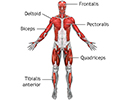Muscle disorder
Myopathic changes; Myopathy; Muscle problemA muscle disorder causes patterns of weakness, loss of muscle tissue, electromyogram (EMG) findings, or biopsy results that suggest a muscle problem. The muscle disorder can be inherited, such as muscular dystrophy, or acquired, such as alcoholic or steroid myopathy.
Muscular dystrophy
Muscular dystrophy (MD) is a group of inherited disorders that cause muscle weakness and loss of muscle tissue, which get worse over time.

The medical name for muscle disorder is myopathy.
Symptoms
The main symptom is weakness.
Other symptoms include cramps and stiffness.
Exams and Tests
Your health care provider will take your medical history and perform a neurological exam. Tests that may be ordered include:
- Blood and urine tests
-
Electromyography (EMG) and nerve conduction studies (NCS)
Electromyography
Electromyography (EMG) is a test that checks the health of the muscles and the nerves that control the muscles.
 ImageRead Article Now Book Mark Article
ImageRead Article Now Book Mark Article -
Muscle biopsy
Muscle biopsy
A muscle biopsy is the removal of a small piece of muscle tissue for examination.
 ImageRead Article Now Book Mark Article
ImageRead Article Now Book Mark Article - Genetic tests to look for conditions that run in families. This can be tested with blood work or sometimes saliva testing.
A muscle biopsy examines a tissue sample under a microscope to confirm disease. Sometimes, a blood or saliva test to check for a genetic disorder is all that is needed based on someone's symptoms and family history.
Treatment
Treatment depends on the cause. It usually includes:
- Bracing
- Medicines (such as corticosteroids in some cases)
- Enzyme replacement therapy
- Gene replacement therapy
- Physical, respiratory, and occupational therapies
- Preventing the condition from getting worse by treating the underlying condition causing the muscle weakness
- Surgery (sometimes)
Your health care provider can tell you more about your condition and treatment options.
References
Borg K, Ensrud E. Myopathies. In: Frontera WR, Silver JK, Rizzo TD Jr, eds. Essentials of Physical Medicine and Rehabilitation: Musculoskeletal Disorders, Pain, and Rehabilitation. 4th ed. Philadelphia, PA: Elsevier; 2019:chap 136.
Doughty CT, Amato AA. In: Jankovic J, Mazziotta JC, Pomeroy SL, Newman NJ, eds. Bradley and Daroff's Neurology in Clinical Practice. 8th ed. Philadelphia, PA: Elsevier; 2022:chap 109.
Selcen D. Muscle diseases. In: Goldman L, Cooney K, eds. Goldman-Cecil Medicine. 27th ed. Philadelphia, PA: Elsevier; 2024:chap 389.
-
Superficial anterior muscles - illustration
Superficial muscles are close to the surface of the skin. Muscles which lie closer to bone or internal organs are called deep muscles.
Superficial anterior muscles
illustration
Review Date: 12/31/2023
Reviewed By: Joseph V. Campellone, MD, Department of Neurology, Cooper Medical School at Rowan University, Camden, NJ. Review provided by VeriMed Healthcare Network. Also reviewed by David C. Dugdale, MD, Medical Director, Brenda Conaway, Editorial Director, and the A.D.A.M. Editorial team.


